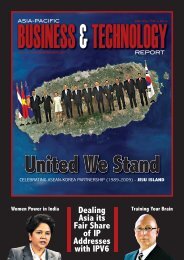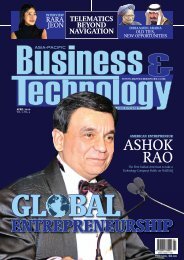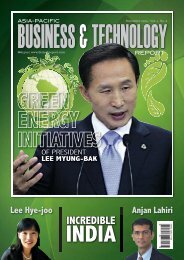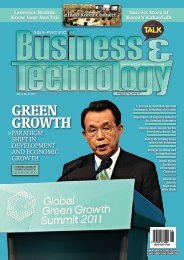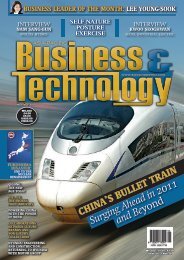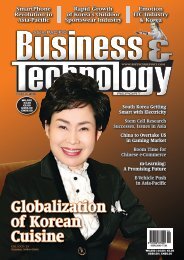INDIA-KOREA - Asia-Pacific Business and Technology Report
INDIA-KOREA - Asia-Pacific Business and Technology Report
INDIA-KOREA - Asia-Pacific Business and Technology Report
You also want an ePaper? Increase the reach of your titles
YUMPU automatically turns print PDFs into web optimized ePapers that Google loves.
Q<br />
a &<br />
Yeo-Song ParkDirector of the Indian Art Museum<br />
By Lakhvinder Singh<br />
<strong>INDIA</strong>-<strong>KOREA</strong><br />
Glorious Past Bright Future<br />
Congratulations on your new<br />
museum opening. First off, how<br />
long have you been associated<br />
with India? What attracts you<br />
most there?<br />
Since 1981 when I visited India for the<br />
first time as an art student, I have been fascinated<br />
by Indian folk <strong>and</strong> tribal arts <strong>and</strong><br />
crafts. So my association with India has<br />
gone on now for more than 30 years. Indian<br />
art <strong>and</strong> culture attracts me most there.<br />
How did you get the idea of<br />
setting up this museum?<br />
Korean people are fascinated by Indian<br />
art <strong>and</strong> culture. Every year thous<strong>and</strong>s of<br />
Korean people visit India to experience<br />
it. A need was felt for an Indian Museum<br />
here in Korea for Korean people to continuously<br />
enjoy <strong>and</strong> experience the Indian<br />
culture right here on their own soil.<br />
What is the main purpose of<br />
setting up this museum in the<br />
Korean countryside?<br />
The museum seeks to connect the Korean<br />
people with the great Indian culture<br />
<strong>and</strong> civilization.<br />
To set up a museum like this<br />
requires a lot of resources. Are<br />
you being helped by the Korean<br />
government or other private or<br />
government institutions? Or is it<br />
purely a personal, private effort<br />
on your part?<br />
To set up an Indian art museum in Korea<br />
had been my long-cherished dream<br />
since 1981. In 2011, I was finally invited to<br />
set it up in Yeongwol county, in Gangwondo.<br />
Yeongwol county is known as the only<br />
museum village in Korea which provides<br />
financial <strong>and</strong> administrative support to<br />
various kinds of museums invited to run<br />
in Korea.<br />
So yes, we are getting some help from<br />
Korea government in setting up this museum.<br />
What are the main attractions<br />
of the museum? Please tell us<br />
about the main items being<br />
displayed in the museum.<br />
There are many attractions specifically<br />
related with Indian paintings. Our collections<br />
include various kinds of paintings,<br />
like Madhubani paintings, Warli tribal<br />
paintings <strong>and</strong> Kalamkari paintings; various<br />
kinds of sculptures, such as Bastar<br />
sculptures, Gond tribal sculptures, Naga<br />
statues <strong>and</strong> panels, Buddha statues, many<br />
Hindu god <strong>and</strong> goddess statues. Plus, there<br />
are various textiles works, potteries <strong>and</strong><br />
jewels. Other kinds of Indian folk <strong>and</strong><br />
tribal arts <strong>and</strong> crafts are also displayed in<br />
the museum.<br />
Ms. Yeo-Song Park was born in Seoul in February of 1954. After graduating from<br />
the College of Fine Arts, Seoul National University, in 1976, she worked as postage<br />
stamp designer in the Ministry of Information & Communication of Korea from<br />
1976-1981. She went to India in 1981 <strong>and</strong> studied Indian Traditional Dyeing Art at<br />
New Delhi from 1981 to 1984. She has since held many solo exhibitions in New<br />
Delhi, including the Commemoratory Exhibition of the 30 Year Anniversary of Indo-Korea<br />
Diplomatic Relations. She has also traveled all over India <strong>and</strong> researched<br />
many Centers of Indian Art, particularly tribal art museums. On May 26th, 2012 she<br />
opened a new Indian Art Museum in Yeongwol-county, Gangwon-do, Korea. Here are<br />
excerpts of the interview <strong>Asia</strong>-<strong>Pacific</strong> <strong>Technology</strong> did with her in her office in Yeongwol<br />
on the occasion of the opening of this new museum.<br />
Director of India Art Museum, Mrs. Yeo-Song Park.<br />
You have collected quite a<br />
number of items here. How long<br />
did it take you to collect them?<br />
I have collected some 1000 beautiful<br />
pieces of Indian arts <strong>and</strong> crafts since 1981.<br />
I have lived in India for more than five<br />
years (from 1981 to 1984 <strong>and</strong> from 1994 to<br />
1996). And I also visited India many times<br />
for the show of my exhibitions in New<br />
Delhi.<br />
I have been fascinated by Madhubani<br />
paintings, Warli tribal paintings <strong>and</strong> Kalamkari<br />
paintings for a long time. These<br />
painting gets prominent place in the museum,<br />
along with various kinds of sculptures<br />
<strong>and</strong> panels which I have collected<br />
over the years. Also displayed are<br />
various types of Buddha statues <strong>and</strong><br />
many Hindu gods <strong>and</strong> goddesses.<br />
What is the main theme of<br />
the museum?<br />
Through the arts <strong>and</strong> crafts of<br />
various folks <strong>and</strong> tribals displayed<br />
in the museum, I am trying to introduce<br />
the special character of Indian<br />
culture <strong>and</strong> society, namely, diversity<br />
<strong>and</strong> unity, to Korean people.<br />
As you know, India <strong>and</strong><br />
Korea have long<br />
historical ties. This<br />
museum will help<br />
reconnect those<br />
historical bonds<br />
between the two countries <strong>and</strong><br />
people.<br />
You are right. Relations between the<br />
two countries are said to date back more<br />
than 3000 years ago. Buddhism, which<br />
came from India, had long-lasting impact<br />
on Korea history, culture <strong>and</strong> its<br />
way of life. Influence of Indian culture,<br />
especially of Buddhist traditions, can be<br />
seen on the life of today’s Korean people.<br />
Our museum aims to connect Koreans<br />
with that glorious past of our two countries.<br />
According to your views, what<br />
is the future of India-Korea ties<br />
in general?<br />
I think India-Korea ties have a great<br />
future. Trade ties are growing very fast.<br />
Government-to-government ties are also<br />
improving, with many high profile visits<br />
taking place in recent years. People-topeople<br />
ties are also set to increase. The<br />
number of Indian people living in Korea<br />
has increased many-fold in recent years.<br />
A large number of Korean people are<br />
nowadays also visiting India every year<br />
for studies, business <strong>and</strong> cultural tourism.<br />
So the future of relations between<br />
two countries looks very bright indeed.<br />
Apart from this museum,<br />
what are your future plans<br />
to promote ties between the<br />
two countries?<br />
In addition to the exhibition of various<br />
Indian arts <strong>and</strong> crafts, the museum<br />
will operate many programs of<br />
experiencing Indian culture,<br />
like seeing Indian movies,<br />
listening to Indian music,<br />
wearing Indian<br />
costumes, making<br />
block-printing, etc.<br />
These programs will<br />
help to further stimulate<br />
<strong>and</strong> contribute<br />
to the interests<br />
of Indian culture to<br />
Korean people. A-P<br />
Statue of Lord<br />
Buddha<br />
26<br />
www.biztechreport.com



